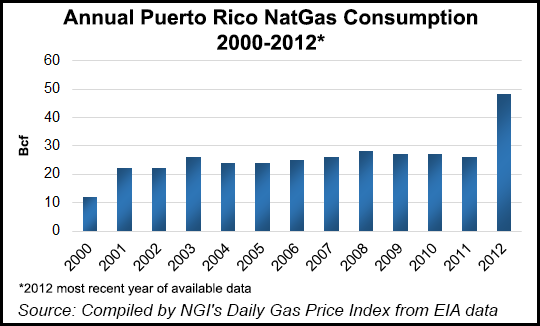Regulatory | Infrastructure | LNG | NGI All News Access
FERC Staff OKs Offshore LNG Port For Puerto Rico Power Plant
FERC staff has issued a favorable final environmental impact statement (FEIS) for the Aguirre Offshore GasPort Project to serve the Puerto Rico Electric Power Authority (PREPA) with liquefied natural gas (LNG) receipt, storage and regasification.

The project is proposed by Aguirre Offshore GasPort LLC, a unit of Excelerate Energy LP, and would serve PREPA’s existing Aguirre Power Complex in Salinas, Puerto Rico (see Daily GPI, Aug. 7, 2014).
The project would include the construction and operation of an offshore marine LNG receiving facility and a four-mile subsea pipeline connecting the Offshore GasPort to the Aguirre Plant. A floating storage and regasification unit would be moored at the offshore berthing platform on a semi-permanent basis, according to the Federal Energy Regulatory Commission [CP13-193].
The port would be about three miles off the southern coast of Puerto Rico, about one mile outside of Jobos Bay and near the towns of Salinas and Guayama.
Availability of regasified LNG would allow the power plant to have dual-fuel generating capability by burning either natural gas or diesel for its combined-cycle units and fuel oil/natural gas for the thermoelectric plant.
“The project would contribute to the diversification of energy sources in Puerto Rico, allow the Aguirre Plant to meet the requirements of the [U.S. Environmental Protection Agency’s] Mercury and Air Toxics Standard rule, reduce fuel oil barge traffic in Jobos Bay, and contribute to energy price stabilization in the region,” the FEIS said. “Aguirre LLC is proposing to place the project facilities in service in 2016.”
According to the project’s website, “PREPA recognizes the urgent need to reduce the dependence on oil and increase the use of natural gas to stimulate economic development, attract industries, improve the quality of life and create more jobs on the island. Using natural gas at the Aguirre Power Plant will reduce the cost of fuel at the plant, a move that could result in cheaper electricity for the entire island.
“The Aguirre Power Plant was selected because it has the largest power-generation capacity on the island and highest fuel cost of all PREPA’s facilities. Converting the Plant to natural gas will yield the most savings to the island.”
A U.S. Energy Information Administration (EIA) report from 2013 said Puerto Rico does not produce natural gas, and all gas is imported as LNG through the Penuelas terminal and regasification facility at Guayanilla Bay. This facility was built to supply the 540 MW EcoElectrica generating plant on the southwestern coast. LNG for Puerto Rico is imported mainly from Trinidad and Tobago, according to EIA. Puerto Rico’s per capita natural gas consumption is less than one-tenth of the U.S. average, according to EIA. The Aguirre Offshore GasPort would be Puerto Rico’s second such facility.
FERC staff found that the project would have “limited adverse environmental impacts that would mostly occur during construction, provided the subsea pipeline does not cross the Boca del Infierno pass via a direct lay.”
© 2024 Natural Gas Intelligence. All rights reserved.
ISSN © 1532-1231 | ISSN © 2577-9877 |
